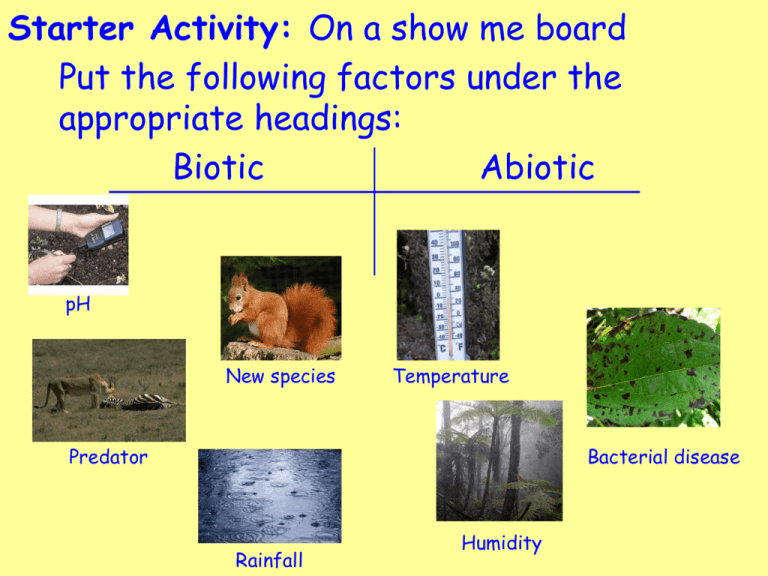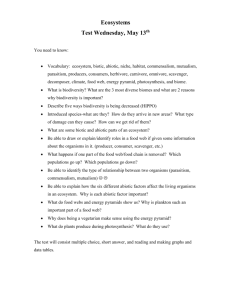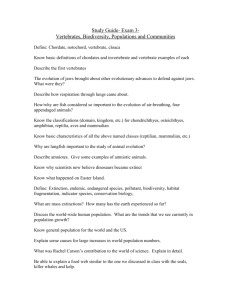3.3b Describing biotic and abiotic factors
advertisement

Starter Activity: On a show me board Put the following factors under the appropriate headings: Biotic Abiotic pH New species Temperature Predator Bacterial disease Rainfall Humidity Biotic and Abiotic Factors Learning Intention: Identify, describe and explain factors that can affect biodiversity and the distribution of living things. Success Criteria: • Identify non-living factors that can affect biodiversity. • Identify living factors that can affect biodiversity. • Explain the impact of biotic factors on biodiversity. • Explain the impact of abiotic factors on biodiversity. RECAP What can affect Biodiversity? The following things can affect levels of biodiversity: • Abiotic factors • Biotic factors What do they mean to you? Think Pair Share Watch the following Glow video clips and add any further information to your show me board: Abiotic Factors Biotic Factors Ecosystem Key Words Add the meaning, with examples, of biotic and abiotic factors to your key word page Key Word Ecosystem Habitat Niche Community Species Population Abiotic factor Biotic factor Biodiversity Meaning Example Grazing and Biodiversity What is grazing and how might it affect levels of biodiversity? Grazing and Biodiversity • Grazing is when a herbivore feeds on plant material. • Grazing is an example of an abiotic factor affecting biodiversity. • Different levels of grazing affect biodiversity in different ways: Levels of grazing and biodiversity Think about the following: Different levels of grazing can be described by the intensity of grazing. The impact of grazing on biodiversity depends on how well the different plant species can re-grow and survive .” In pairs discuss how low, medium or high intensity grazing might affect the survival of different plant species. Grazing and Biodiversity Level of grazing Level of biodiversity Low intensity Low biodiversity Medium intensity High biodiversity High intensity Low biodiversity Reason Impact of predator and prey on biodiversity • Predation is when an animal hunts and kills another animal to consume it for energy. • Predation is an example of an abiotic factor affecting biodiversity. Predator and Prey How does the relationship between predator and prey affect biodiversity? Predator and Prey Describe what is happening in this graph Predator and Prey • Sketch the graph below and describe the relationship between the number of predators and prey: Abiotic factors affecting biodiversity • pH and temperature are examples of abiotic factors that can affect biodiversity. • In pairs discuss how and why these factors might affect levels of biodiversity and note your answers on a show me board: Temp. pH Temperature Abiotic factors affecting biodiversity • pH and temperature are examples of abiotic factors that can affect biodiversity. • pH can affect biodiversity by: • Temperature can affect biodiversity by: Biotic and Abiotic Factors Learning Intention: Identify, describe and explain factors that can affect biodiversity and the distribution of living things. Success Criteria: • Identify non-living factors that can affect biodiversity. • Identify living factors that can affect biodiversity. • Explain the impact of biotic factors on biodiversity. • Explain the impact of abiotic factors on biodiversity. Biotic and Abiotic Factors Learning Intention: Identify, describe and explain factors that can affect biodiversity and the distribution of living things. Success Criteria: • Identify non-living factors that can affect biodiversity. • Identify living factors that can affect biodiversity. • Explain the impact of biotic factors on biodiversity. • Explain the impact of abiotic factors on biodiversity. Investigating Human Activity 1. Choose one example of how human activity can influence biodiversity. 2. Find information from at least two different sources, say what the sources are and why you chose them using the following words: relevant, reliable or perspective. 3. Find some statistics about your chosen human activity: present them in an appropriate way and process the data e.g turn a table into a graph or perform a calculation on the data. 4. Summarise your findings in 50 to 100 words, with a conclusion which is backed up by quoting your data. 5. Present your investigation on A4 paper.




